The process of drawing a football player with a ball using a pencil is quite complex and requires not only to schematically depict the proportions of a person, but also to show his precise movements, the moment of hitting the ball, as well as the expression emanating from the exciting game.
Necessary materials and stages of drawing
Football is one of the favorite sports for men of all ages, who closely follow the world and European championships, the Champions League, smaller qualifying competitions, and the transfer of athletes. Favorite athletes can be captured on a piece of paper.

For the drawing lesson you will need:
- a voluminous sheet of album paper;
- well-sharpened pencils of varying degrees of hardness H, HB and B;
- eraser;
- colored pencils or liner.
The creation of a drawing is carried out in several stages:
| Stage | Description |
| 1 | Schematic representation of the human frame, observing the basic proportions of the body |
| 2 | Drawing of the football player's figure, his limbs, design of the hands of the body, sports uniform and boots |
| 3 | Working with the athlete's facial features: placement and clear drawing of hair, eyes, lips, eyebrows, mouth and ears. |
| 4 | The distribution of small details in the drawing, including the ball itself and its ornament, folds in the clothes, and the contours of the body visible under the uniform |
| 5 | Working with light and shadow to add visual volume to a drawing |
Work execution procedure
A football player with a ball (a step-by-step drawing is given below in the article) can be depicted in different positions: as a forward, a goalkeeper or a defender.
Any of these drawings should begin with a schematic representation of the person himself using small circles located in the place of the head, chest and hips, as well as lines defining the position of the athlete's legs and arms.
It is advisable to mark the location of the knees, feet, shoulders, hands and hips with small circles., allowing you to avoid making mistakes in choosing body proportions in the future.
Next, focusing on the central schematic lines of the circle, which served as shoulders, hands, hips and shins, you need to use semicircular lines that transform into simple geometric figures to connect the parts of the body with each other, defining the frame of a person.
The circle that replaces the football player's face is divided here by horizontal and vertical axes into 4 parts, which are necessary for drawing the facial features. Since the player is depicted in motion, one of his legs should be slightly longer than the other, and the second should be bent at the knees. The same can be said about the person's arms, one of which is slightly moved to the side.
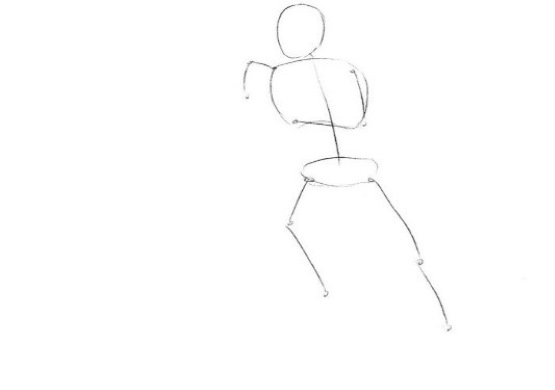
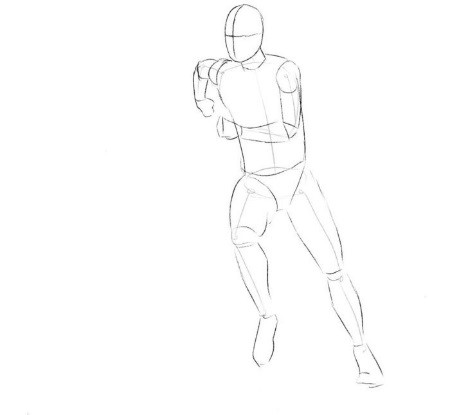
After creating the outline of the body, using the axes, you need to draw the mouth, nose, eyes and hair of the attacker. In this case, the football player’s organs of vision should be located in the upper part of the circle, on the horizontal axis, and the nose and mouth should be in the lower semicircle, on the vertical axis.
The ear of the attacker is also drawn, starting from the horizontal axis and located in the lower, fourth semicircle. At a small distance from the football player, the circumference of the ball is drawn. The athlete's clothing is also outlined with a thin pencil line H.
From the resulting drawing, you need to remove the auxiliary lines and draw the athlete's facial features more clearly. Eyebrows and hair are drawn on the face, and then you can begin detailing the body parts.
Here the contours of the neck and its muscles are drawn, a T-shirt with a cutout covering the contours of the body. When creating a T-shirt, you should focus on creating folds located in places of compression and stretching of the fabric.
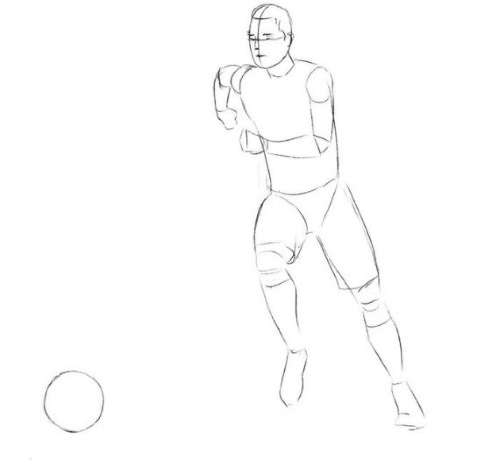
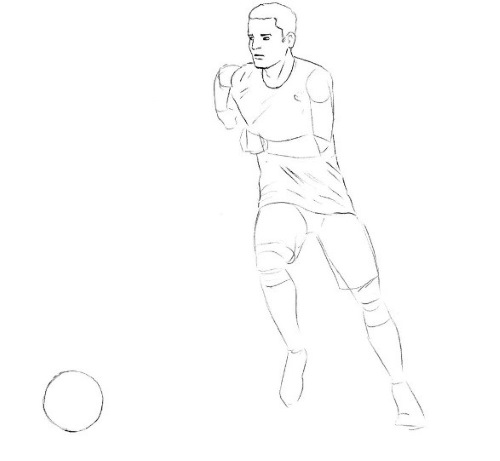

After completing the torso, attention is transferred to drawing the arms and legs of the football player. Here, smooth lines should be used to create the contours of the limbs, without forgetting about the athlete's biceps, triceps and deltoid muscles in motion, clearly visible under the sleeves of the football uniform.
In the armpit area, folds of clothing are drawn, and this stage is completed by drawing the hands clenched into fists.
Having finished working with the upper part of the body, you can move on to the footballer's legs. The shorts here need to be stretched out and the necessary folds that appear when running added to them. Next, the lines of the shins and knees are stretched out, and then the gaiters and details of the athlete's boots are clearly drawn.
Once the process is complete, all auxiliary lines can be removed, and using a soft pencil, clearly draw the central contours of the athlete.

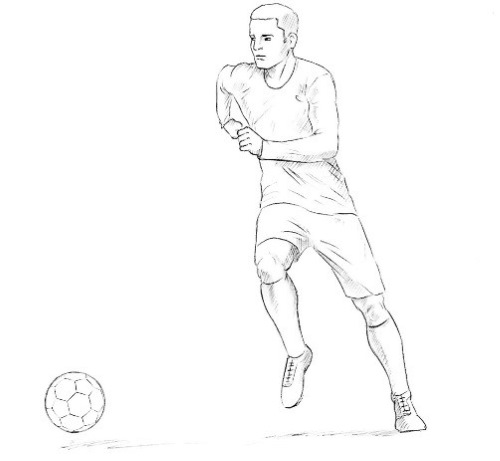
The final stage of drawing is shading and drawing shadows. Since the light falls on the central part of the football player's face and body, you can use shading to darken the area at the temples, under the knees and on the sides of the athlete's body. You need to design the ball by drawing a characteristic football pattern on the circle.
Defender
A football player with a ball (the drawing is quite difficult for small children to perform and requires the help of adults) can play in various positions, including defender and goalkeeper. A defender is a player whose job is to take the ball and kick it out of the danger zone, thereby preventing the attacker from shooting at the goal.
As with the first drawing, the first step here is to draw the athlete's frame by bending his body parts. In places of bends (knees, shins, shoulders and hips) you should put small dots, which are necessary later for drawing the human body and correct design of shadows.
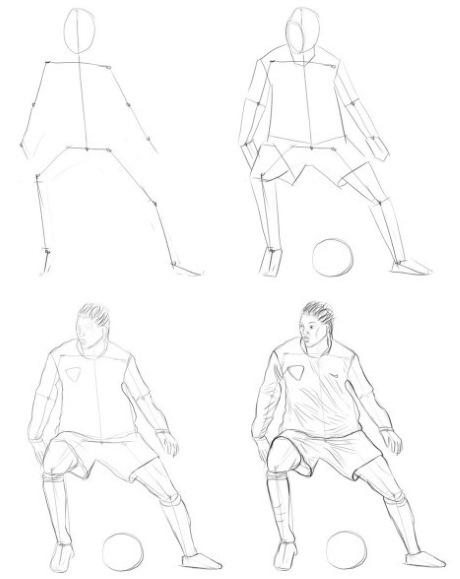
At the second stage, connecting the dots with simple geometric figures, the frame of the athlete's body is created. Also, the neckline, the athlete's T-shirt and his shorts are designed with schematic lines.
Since the football player's face is slightly turned to the side, the central circumference of the head should be divided not into 4, but into 2 parts, using for this purpose an oval placed on the left side of the head. The ball is placed between the defender's legs and is designated in the form of a circle.
The next step is to draw the athlete's facial features and hair, and then, gradually removing auxiliary lines, the shape of the human body is changed. At the last stage, the folds on the athlete's clothing are drawn and auxiliary lines are removed. With the help of hatching, parts of the athlete's body hidden from the light are formed.
Sergio Ramos
A football player with a ball (the drawing should be done with pencils of different hardness) is made by cells using a regular notebook sheet. Here, depending on your desire, you can depict either an ordinary player or a real football star, since the width of the cells allows you to accurately convey the facial features of almost any player.
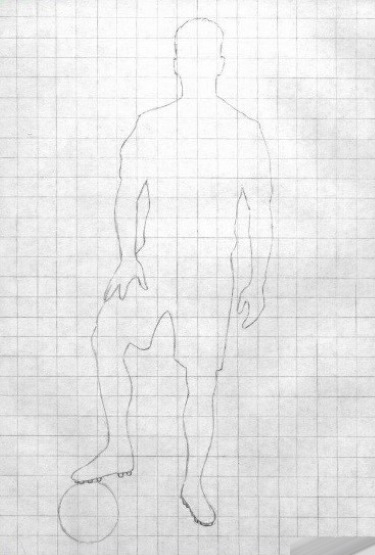
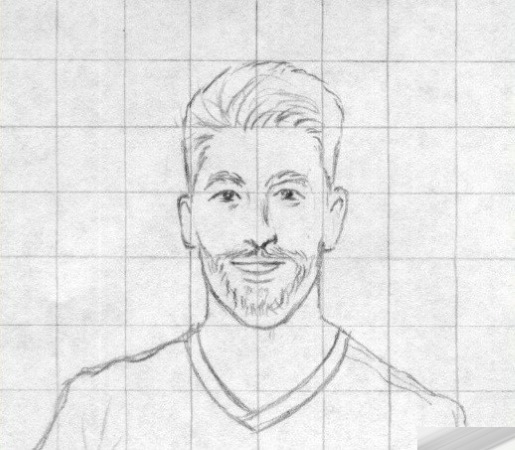
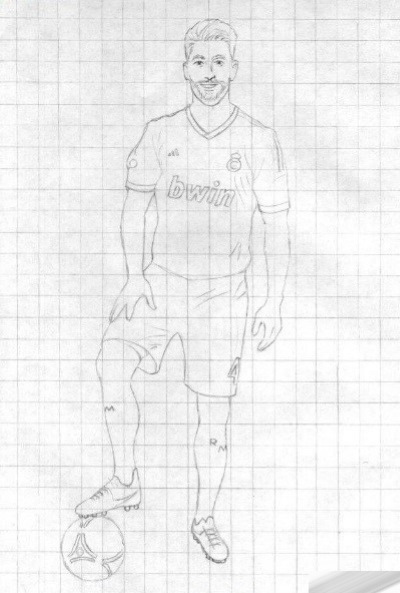
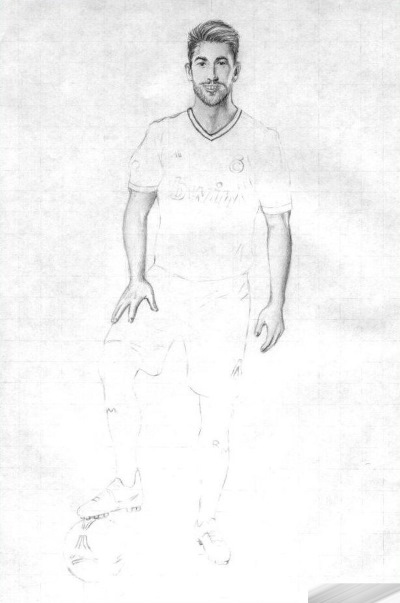
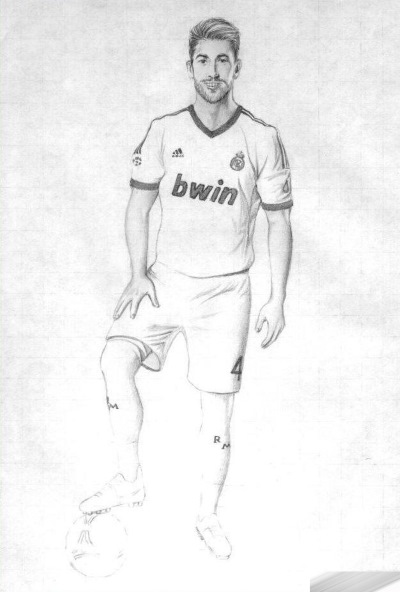
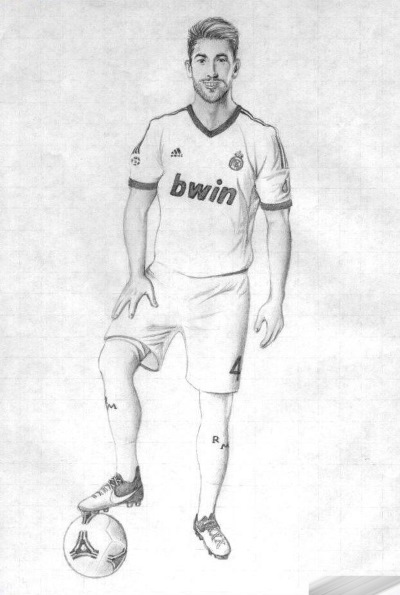
Sergio Ramos can be drawn on a squared A4 notebook sheet, having previously divided it into 2 parts. The silhouette of the footballer is indicated with a hard pencil, capturing the contours of the human body and the ball.
Using the H pencil, create the facial features of the athlete, in this case Sergio Ramos, using strokes and clear lines. The same pencil should be used to draw the uniform of the team captain and the main star of Real Madrid, as well as his boots and the ball. Using the soft B pencil, highlight the facial features and apply shadows.
Using exactly the same movements, shadows should be applied to the body and shape, and then to the ball and the footballer's boots. You can paint over the background with a black marker, adding additional emphasis and volume to the drawing.
How to draw a striker
A football player with a ball is a drawing that requires conveying not only the dynamics, but also the expression of the athlete. Special attention is given to both the observance of the proportions of the human body and the artistic transmission of the mood and character of the character, carried away by the process of the game.

At the first stage, a sketch of the athlete is created, for which a curved line is drawn from the circumference of the head to the bottom, connecting it with a slightly larger circumference. According to the canons of creating the human body, this number should be increased by 2 times, compared to the volume of the head.
And then additional lines of arms are drawn in different directions from the central line of the spine, indicated in places of shoulders, elbows and hands by small circles - dots. Lines should also be drawn from the hips, necessary for drawing the legs of the athlete running on the field.
Creating the basis of the drawing from the lower circle in a wide run-up, the football player's legs are drawn: to the knee joint, outlined in the form of a small circle, the distance should be approximately 2 head heights. After the knees, you can begin to create the shins and calves of the athlete, the length of which should also correspond to 2 head heights.


On the upper part of the body, slightly stepping back from the head, you need to create the torso of the football player, depicting it in the form of an oval, from the upper part of which lines of arms are drawn, thrown back in a run. Elbow joints can be depicted as circles, and at the bottom of the head circle, a triangle is drawn, necessary for creating the chin.
Since the footballer is captured in the process of running, his left leg should be bent at the knee joint and be slightly smaller than the first. In the lower part of the body, moving from the lower circle, you need to draw massive legs, remembering that at the thigh they should be larger than in the shin area.
The ovals also represent the player's feet. The player should be dressed in a football shirt and shorts, not forgetting about the folds in the clothing that appear during movement. The athlete wears boots and high socks.
Once you have finished drawing the body, you can focus on the facial features, drawing a determined and concentrated look, pursed lips, slightly frowning eyebrows and a strong chin. On the athlete's head there is hair fluttering as he runs. To complete the drawing, near the football player's leg you need to draw a circle of a sword.

The auxiliary lines of the drawing can be erased at the final stage, highlighting the contours of the face and body with bold lines.Colored pencils, pastels or paints will add brightness to a black and white drawing. The folds on the clothes should be darkened with hatching or a darker shade, and the distinctive signs of a football club should be drawn on the clothes.
The ball near the footballer's left foot should be left white, slightly darkened with hatching to give it volume. You can sketch out a pattern typical of a football.
How to draw a boy
A football player with a ball (a cartoon-type drawing is quite simple to make and is easily accessible even to a beginner, little artist) can also be made in the form of a boy playing football.
There is no need to draw details or shadows here. It is enough to simply concentrate on creating a human body in motion. As an addition to the drawing, you can depict a football field and goals. You need to start the drawing in the central part, where the football player will be depicted:
At the top of the face, draw an arc, outlining the child's head and the crown of his head, and then draw the zigzag bangs and the rest of the boy's hair.
Drawing short lines down from the hairdo, you need to draw the boy's head and ears. The latter should be slightly rounded and placed on both sides of the central part of the face. Finishing the creation of the head, you need to draw 2 additional lines down from the ears, connecting them in the center of the drawing.
To design the shoulder and neck area, you need to draw semicircular lines on both sides of the head.
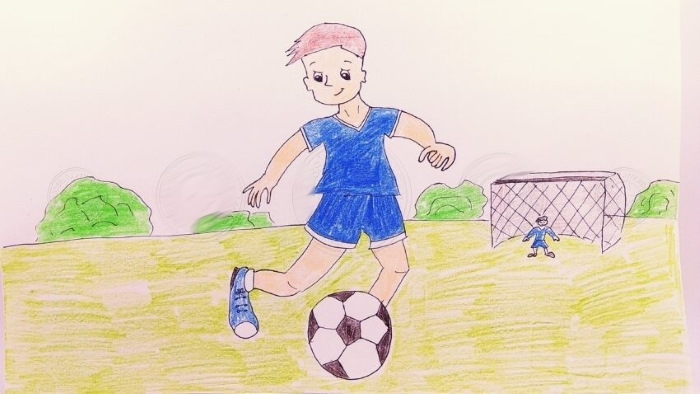
Since the athlete is wearing a short-sleeved T-shirt, you should first draw them, and then the hem of the uniform, drawing lines to the middle of the sheet. At the bottom of the T-shirt, you should draw rectangular shorts, slightly smaller in size than the upper part of the body.
To show that the uniform is athletic, you can draw stripes on the collar, base and sleeves of the T-shirt and shorts. The next step is to draw parts of the body. Using wavy lines, create a hand with a wrist and fingers. The hand should be raised up, and the wrist should be positioned so that it looks straight.
The second hand is drawn in exactly the same way, except that the fingers on the hand can be spread and lowered down. The legs should be drawn starting from the line of the boy's shorts. One of them will be set aside as if the football player is about to kick the ball and bent at the knee.
The leg is completed by boots, with lacing drawn on it, tied in a bow. The second leg should be bent at the knee, but instead of a boot, there will be a ball here, hiding the player's shin.

When shaping the face, you need to draw the eyes, nose and mouth of the child. Using the pupils, the football player's gaze should be slightly lowered, showing that he is following the ball with his eyes. The eyebrows and mouth can be slightly curved.
Having drawn the football player, you can start to design the background of the drawing. At the level of the boy's shorts, you should draw a slightly curved horizontal line to create a football field, and draw wavy ovals to it, serving as trees and bushes.
Here, in the background, you need to draw a football goal, placing it in a semicircle. In front of the goal, you can put another, small figure of a goalkeeper.
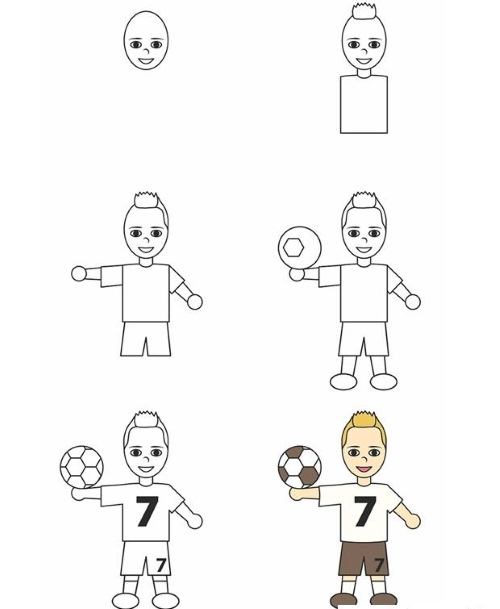
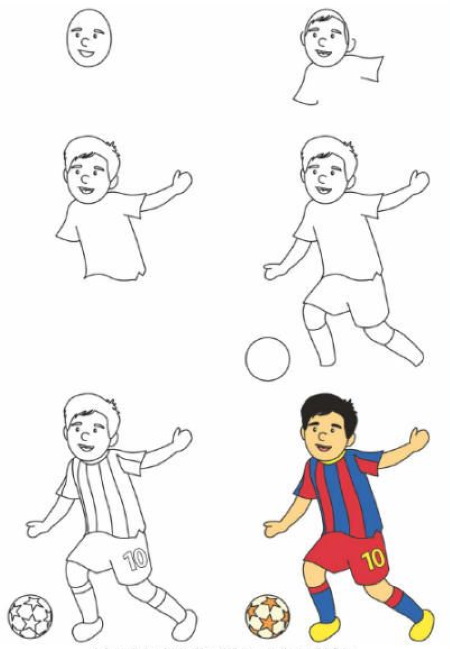
The resulting drawing can be colored with colored pencils:
- bright blue color should be used for football uniforms;
- the stripes on the T-shirt and shorts can be left white;
- To design the ball you will need a black pencil, and the open areas of the boy's body are shaded with a beige shade.
You can use a yellow pencil to color the football field, and use a green one to decorate the bushes. The football goals are painted in a lilac shade, and the goalkeeper's uniform in bright blue.
How to draw a soccer goalkeeper
A football player with a ball is not only an active player on the field, but also a goalkeeper, whose skill and reaction largely determines the outcome of the game.
To create a drawing of a goal defender catching a ball, first, using geometric figures, you need to sketch the outline of the goal and the athlete himself jumping for the ball. The circle in the drawing is later needed not to draw the head, but to create a soccer ball.
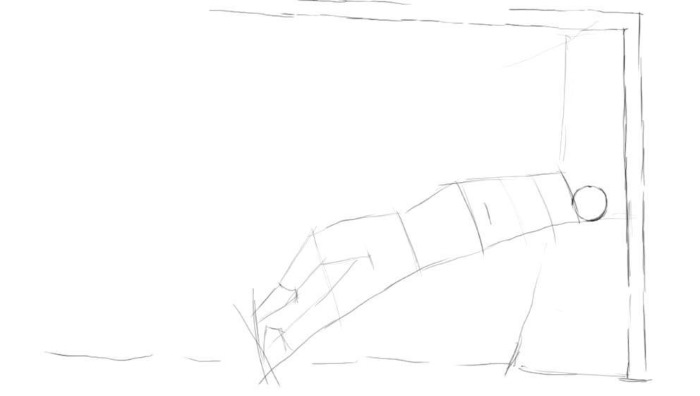
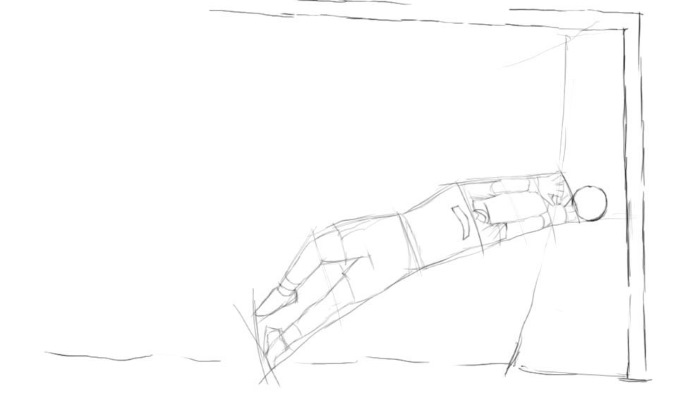
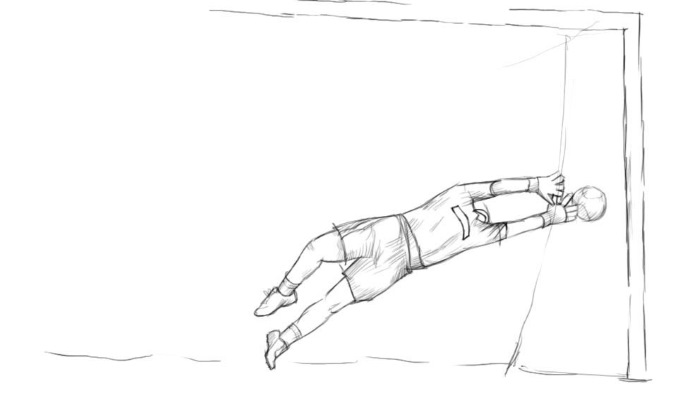
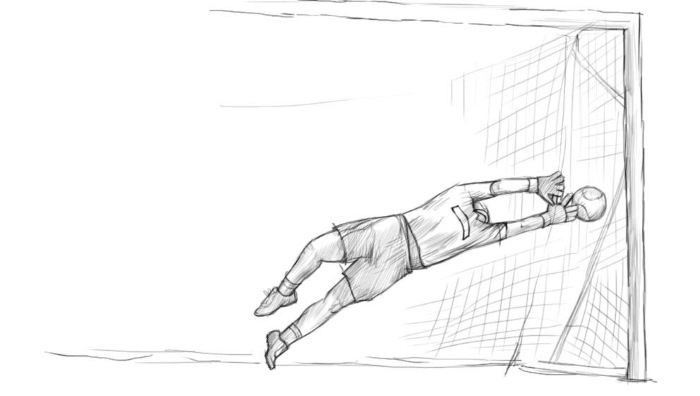
The second stage of the drawing is drawing the body parts: the arms, legs and body of the defender. On the body of the goalkeeper, the lines of his uniform (T-shirt and shorts), boots and goalkeeper gloves are schematically drawn.
Having decided on the silhouette of the goalkeeper, you need to use small lines to draw the folds that appear on the clothes during the jump, and then you can delete all the auxiliary lines, and shade the outlines of the drawing with a softer pencil. At the final stage, you need to draw the goal net, and also apply shadows to the picture, placing them in the direction of the falling light.
A football player with a ball is a rather complex drawing to execute, requiring the player to convey not only the movements, but also the emotions of the player trying to score, kick or catch the ball.
Creating a legendary football player or an ordinary boy playing in the yard takes 4 full stages, requires special attention to detail and the ability to work with shadows and shading, which are necessary to give the drawing volume and realism.
Video about drawing
Football player with ball drawing:
